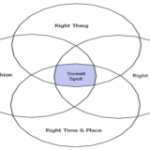There are a lot of considerations to be dealt with when putting together an effective business website. Will you use an open source CMS platform such as WordPress, Joomla or Drupal, or will you code it from scratch? What will be the site’s architecture, what sort of image of the business do you want to convey… even more basic, what will be the business model you’ll follow online?
Sometimes, even if you make the best choices for all of those, your site still just doesn’t perform for you. You may have a great product, favorable pricing, outstanding customer service and seemingly have everything going for you. But still, if it wasn’t for referrals, you wouldn’t have enough sales to make it worth the effort. Something’s wrong.
Which raises the question, what’s your content strategy?
What are the Goals?
We’ll start by assuming you have the product or service already available, along with the infrastructure to handle sales. From that point, your basic goals will be to put your website in front of prospective buyers and convince them to make the purchase. That’s pretty basic, but it’s a good starting point.
Or is it? Would you invite a crowd of people to your housewarming party the same day your furniture is scheduled to arrive? Of course not. You’ll wait until you’re reasonably settled in, with your new home in a presentable state, so as to make a good impression, right?
Going after traffic for a website that isn’t totally in order is not the way to go about either making a good impression or closing sales. In fact, there are a number of things you want to be sure to take care of before you even allow the search engines to visit your site.
Again, we’ll jump ahead, and assume that your developer or your SEO consultant have already handled those concerns (if you didn’t have someone intimately familiar with search engine guidelines and information retrieval techniques, you may have a rough road ahead of you).
In order to ensure you can achieve your goals, you first have to be sure you’ve identified them properly and are attacking each of them the right way. Surprisingly, many online businesses fail to clearly identify each of the individual goals of running their online business.
Determine precisely what you want to achieve with every aspect of your site, whether it’s informational, functional or a call-to-action. If it serves no purpose, it probably shouldn’t be there, and if it’s not serving its purpose effectively, it needs to be adjusted.
How to Achieve the Goals
One of the first steps you should have taken is to perform a thorough keyword analysis. Knowing what search terms users employ to find your product is crucial. While there’s no black arts involved in the process of identifying keywords and phrases, it’s not a job to be undertaken without experience – not if you want your site to be successful.
Once you’ve got a thorough listing of keywords and phrases, an analysis will show which of those, both short- and long-tail, you’ll want to incorporate into your content strategy. Those keywords will have to appear on your pages, in the titles, headings and copy (without overdoing it), in order for your page to found relevant by the search engines.
Before you start preparing any of the copy for your pages, though, you need to determine exactly what your entire content strategy will be. You certainly know all about your product or service, but if you’re not presenting it in its best light, you could lose your visitors in the first paragraph.
The basic rules of content strategy are quite simple – in delivering your message, you should say:
 The right thing – Saying the right thing is part marketing, part psychology – one good example is to talk about value, not features. Telling people about your highly polished finish won’t be nearly as convincing as telling them how durable and scratch resistant it is. Save the features for the specifications. You need to convince them that your offering is the offering they’re looking for.
The right thing – Saying the right thing is part marketing, part psychology – one good example is to talk about value, not features. Telling people about your highly polished finish won’t be nearly as convincing as telling them how durable and scratch resistant it is. Save the features for the specifications. You need to convince them that your offering is the offering they’re looking for.
To the right people – This can be a bit trickier to nail down at first. Ideally, you’ll have some idea of the demographic makeup of your audience. If not, you may be able to make good use of some polls, A/B testing or existing market statistics to be able to tailor your presentation to those people most likely to be searching for your offering.
At the right time and place – Different channels, alone or in concert with each other, can be employed to optimize your results. This is the aspect that will usually require the most periodic adjustment. Obviously, slapping visitors in the face with a big “Buy NOW!” button at the top of your landing page probably isn’t going to work out well. And we’ve all seen nightmare examples of promotions that unwisely rode on the back of tragedies – common sense is a critical element here.
In the right fashion – This is part marketing and sometimes a lion’s share of psychology, depending upon your niche, your product and your audience. Finding this ideal approach is probably an aspect that is most often dealt with via A/B testing. The most effective approach can vary wildly between different audiences.
When you’ve polished all four of these aspects of your content strategy, the result will be a “sweet spot” that hits the mark for the largest portion of your visitors. It can shift slightly from time to time, so ongoing monitoring of your site’s performance is still necessary. But adjustments will usually be just a matter of fine-tuning.
What’s the Problem?
So, assuming your site isn’t performing the way you think it should, those are the four elements of your content strategy you need to examine. Quite often, the business owner isn’t the best one to evaluate the content strategy. It’s easy to be too close to a topic to be objective, and a set of outside eyes can often spot false assumptions that can cause us to try to project our feelings onto the users. Intuition can sometimes be helpful, but it shouldn’t be the backbone of your strategy.
Addressing your audience in the right voice and tone, telling them what they need to know, when and where they need it, in a way that builds confidence and trust, is the surest way to provide smooth continuity all the way from the SERPs to your call-to-action.
Content strategy is just one piece of the puzzle, just as are site design, development, attracting targeted traffic and converting that traffic into sales. Failing in any single sub-set of any of these can affect your bottom line, even if all other aspects are perfectly tuned. Troubleshooting any problem will always be more productive when you look at all the details, and often, the solutions must be laser-focused on those details, to get the desired results.
At the end of the day, though, thousands of highly targeted visitors are worthless to you, if your content doesn’t lead to conversions.




